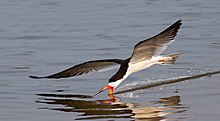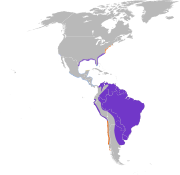Rynchops
| Skimmers | |
|---|---|

| |
| Black skimmer (R. niger) skimming | |
| Scientific classification | |
| Domain: | Eukaryota |
| Kingdom: | Animalia |
| Phylum: | Chordata |
| Class: | Aves |
| Order: | Charadriiformes |
| Family: | Laridae |
| Genus: | Rynchops Linnaeus, 1758 |
| Type species | |
| Rynchops niger (black skimmer) Linnaeus, 1758
| |
| Species | |
| |
The skimmers, forming the
Description
The three species are the only birds with distinctive uneven
They are tropical and subtropical species which lay 3–6 eggs on sandy beaches. The female incubates the eggs. Because of the species' restricted nesting habitat the three species are vulnerable to disturbance at their nesting sites. One species, the
Taxonomy
The genus Rynchops was introduced in 1758 by the Swedish naturalist Carl Linnaeus in the tenth edition of his Systema Naturae.[9][a] The genus name Rynchops is from the Ancient Greek ῥυνχος/rhunkhos meaning "bill" and κοπτω/koptō meaning "to cut off".[11] The type species is the black skimmer (Rynchops niger).[12]
As in later editions of the works of Linnaeus, the correct spelling (from the Greek words ῥύνχος and ὤψ, together meaning "beak-face") should be rhynchops and this is often adopted. However, the misspelling rynchops was the one first published by Linnaeus and continues to be more commonly used.[13] Similarly, the gender of the Greek and Roman words is feminine and the genus was originally treated as such (R. nigra) but Rynchops is now usually treated as a masculine noun (R. niger).
Species
The genus contains three species.[14]
| Common name | Scientific name and subspecies | Range | Size and ecology | IUCN status and estimated population |
|---|---|---|---|---|
| Black skimmer | Rynchops niger Linnaeus, 1758 |
Atlantic coast of North America, and from southern California to Peru in the Pacific, the Amazon basin, Atlantic coast of South America south to central Argentina
|
Size: Habitat: Diet: |
LC
|
| African skimmer | Rynchops flavirostris Vieillot, 1816 |
Senegal to northern Congo River and southern Nile Valley, southern Tanzania to the Zambezi Valley, and then to KwaZulu-Natal Province (South Africa) and Angola | Size: Habitat: Diet: |
LC
|
| Indian skimmer | Rynchops albicollis Swainson, 1838 |
Pakistan in the Indus river system of Kashmir and northern and central India along the Ganges, Bangladesh and Burma and formerly occurred in Laos, Cambodia and Vietnam | Size: Habitat: Diet: |
EN
|
Notes
References
- ^ "scissorbill, n.", Oxford English Dictionary, Oxford: Oxford University Press, 2014.
- ^ Mariano-Jelicich, R; Favero, M.; Silva, M.P. (February 2003). "Fish Prey of the Black Skimmer Rynchops Niger at Mar Chiquita, Buenos Aires Province, Argentina" (PDF). Marine Ornithology. 31: 199–202. Retrieved 2009-06-29.
- PMID 17346347.
- ^ Zusi, RL & D Bridge (1981). "On the Slit Pupil of the Black Skimmer (Rynchops niger)" (PDF). Journal of Field Ornithology. 52 (4): 338–340.
- ^ "THE BIRD BOOK".
- doi:10.1111/j.1474-919X.2007.00706.x.)
{{cite journal}}: CS1 maint: multiple names: authors list (link - ^ Fusco, P.J. "Connecticut Wildlife Archived 2009-09-14 at the Wayback Machine." Connecticut Department of Environment Protection Bureau of Natural Resources – Wildlife Division. May–June 2006. Accessed 2009-06-29.
- ^ "Large dams and barrages are an increasing threat to wetland-dependent birds". BirdLife International. Retrieved 21 February 2014.
- ^ Linnaeus, Carl (1758). Systema Naturae per regna tria naturae, secundum classes, ordines, genera, species, cum characteribus, differentiis, synonymis, locis (in Latin). Vol. 1 (10th ed.). Holmiae (Stockholm): Laurentii Salvii. p. 138.
- .
- ISBN 978-1-4081-2501-4.
- ^ Peters, James Lee, ed. (1934). Check-List of Birds of the World. Vol. 2. Cambridge, Massachusetts: Harvard University Press. p. 349.
- ^ Amaral, A do (1967). "Comment on the gender of names ending in -ops". Bulletin of Zoological Nomenclature. 24 (1): 2.
- Rasmussen, Pamela, eds. (July 2021). "Noddies, gulls, terns, skimmers, skuas, auks". IOC World Bird List Version 11.2. International Ornithologists' Union. Retrieved 16 August 2021.
- ^ Gill, Frank; Donsker, David, eds. (2019). "Noddies, gulls, terns, auks". World Bird List Version 9.2. International Ornithologists' Union. Archived from the original on 8 August 2019. Retrieved 24 June 2019.
External links
- Skimmer videos on the Internet Bird Collection



